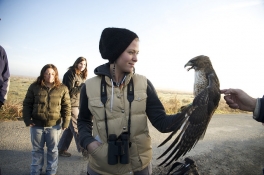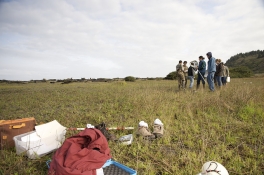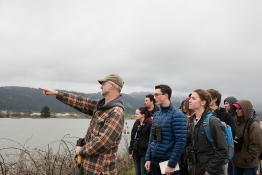David Sinn
Lecturer
Education
Ph.D. in Ecology, University of Tasmania, Hobart, Tasmania (2006)
M.Sc. in Comparative Psychology, Portland State University, Portland, Oregon (2000)
B.Sc. in Marine Biology, Texas A & M at Galveston, Galveston, Texas (1994)
Courses Taught
WLDF 210 Intro to Wldlfe Conserv & Admn
WLDF 309 Environmental Ethics
WLDF 485 Senior Seminar Wildlife Mgmt
WLDF 495 Senior Project
Research
I am currently pursuing several research projects, all with a focus on incorporating diverse, unique, passionate, critically-thinking undergraduate and graduate students:
1) Reintroduction of California sunflower starfish (Pycnopodia helianthoides) into local waters. Disease and climate change have devastated this endangered species along our California coast. This research aims to establish Cal Poly Humboldt as a key partner in the culturing, preservation, and reintroduction of this keystone predator into West coast waters.
2) The impacts of e-waste on wildlife in Ghana. Along with collaborators at the University of Ghana, this work attempts to document the impacts on wildlife of the illegal e-waste trade on fish populations in Agbogbloshie, Ghana.
Previous Research
All of my past research endeavors, at some level, are based on the idea of individual heterogeneity.
Past fundamental research
Some of my past research has demonstrated that personality traits related to growth (e.g., boldness) may be governed by condition-dependent developmental processes that promote phenotypes based on current and recent historical environmental conditions (Sinn, et al. 2008; Fratkin, et al. 2013; van Oers & Sinn 2013). This is in contrast to other traits related to social skills (e.g., conspecific aggression), that appear to be more heavily influenced by genotype-dependent processes (Sinn et al. 2001; van Oers & Sinn 2010; Sinn, et al. 2006). I have also studied how phenotypic plasticity can covary with evolutionary fitness (Fratkin et al. 2013; Sinn et al. 2006; Sinn et al. 2008; Sinn et al. 2010). Theoretically, specifying modes of development for personality in predictive models could significantly alter the rate at which populations respond to disturbance (such as human conflict or habitat loss in animals), but the extent of these effects is currently unknown.
Past applied research
My work with orphaned Tasmanian devils was able to show that exploratory behavior was a strong predictor of translocation success (Sinn et al., 2014); translocation is now a major component of the management ‘tool box’ currently being used by the Save the Tasmanian devil program to combat devil facial tumour disease. My work with odor-detection dogs was designed to help optimize a US detection dog breeding and development center, based on the observation that working dogs have personalities too that determine a dogs’ work performance (Sinn, et al. 2010; Wilsson & Sinn, 2013; McGarrity et al. 2015). For working dogs, one of the critical aspects of current research is identifying behavior relevant to working-life conditions, and figuring out how to measure it well. My past working dog research has shown that when watching the same dog, people may not agree strongly in terms of what the dog is doing (McGarrity et al. 2015; Fratkin et al. 2015). Experts in the field tend to be very good at generally picking puppies that end up being good working dogs as adults (Sinn et al. 2010; Wilsson & Sinn 2013; McGarrity et al. 2015), but the field as yet has been unable to derive reliable quantitative measures of behavior that predict adult behavior based on observations during puppyhood (Fratkin et al. 2013).
Understanding mechanisms of disease transmission in humans and other animals is challenging, and few demonstrations exist of how social contact networks relate to observed disease spread; this is especially the case for parasites like ticks, where infestation occurs when different individuals share the same space (but with a time-lag, because the tick needs to molt or the female needs to hatch her larvae). As part of a larger long-term study, my most recent research has included leading a team of undergraduates and graduate students in an attempt to catch and study all adult lizards in a single study population located in South Australia. We have been documenting lizard space use, social interactions, and movement, and along with measures of size, habitat resources, aggression and boldness, foraging, overnight refuge use, and regular tick counts in order to predict tick transmission. In addition, we added genetically-unique tick larvae to our study population and then collected later life stages. Our field site is part of a larger 32-year long lizard/tick survey. Our work on this system is just now starting to come out in publication.
Publications
Peer-reviewed journal articles
Payne, E., Spiegel, O., Sinn, D.L., Leu. S.T., Gardner, M.G., Godfrey, S.S., Wohlfeil, C., & Sih, A. (2022). Intrinsic traits, social context, and local environment shape home range size and fidelity of sleepy lizards. Ecological Monographs, 92: e1519. https://doi.org/10.1002/ecm.1519.
Michelangeli, M., Payne, E., Spiegel, O., Sinn, D.L., Leu, S.T., Gardner, M.G., & Sih, A. (2021). Personality, spatiotemporal ecological variation and resident/explorer movement syndromes in the sleepy lizard. Journal of Animal Ecology, 91: 210-223.
Noonan, M., Martinez-Garcia, R., Davis, G., Crofoot, M., Kays, R., Hirsch, B., Caillaud, D., Payne, E., Sih, A., Sinn, D.L., Spiegel, O., Fagan, W., Fleming, C., & Calabrese, J. (2021). Estimating encounter location distributions from animal tracking data. Methods in Ecology and Evolution, 12: 1158-1173.
Payne, E., Sinn, D.L., Spiegel, O., Leu, S.T., Gardner, M.G., Godfrey, S.S., Wohlfeil, C., Sih, A. (2021). Consistent after all: Behavioural repeatability in a long-lived lizard across a six-year field study. Animal Behaviour, 174: 263-267.
Payne, E., Sinn, D.L., Spiegel, O., Leu, S.T., Wohlfeil, C., Godfrey, M., Gardner, M., & Sih, A. (2020). Consistent individual differences in ecto-parasitism of a long-lived lizard host. Oikos, 129:1061-1071. http://dx.doi.org/10.1111/oik.06670
Sih, A., Sinn, D.L., Patricelli, G.L. (2019). On the importance of individual differences in behavioural skill. Animal Behaviour, 155:307-317.
Munch K.L., Wapstra E., Thomas S., Fisher M., Sinn D.L. (2019). What are we measuring? Novices agree amongst themselves (but not always with experts) in their assessment of dog behaviour. Ethology, 125:203–211. https://doi.org/10.1111/eth.12846
Sih, A., Ligocki, I., Munson, A., & Sinn, D.L. (2017). Evolutionary behavioral ecology approaches to integration in the study of animal personalities. European Journal of Personality, 31, 568-569.
McGarrity, M.E., Sinn, D.L., Thomas, S.G., Marti, C.N., & Gosling, S.D. (2016). Comparing the predictive validity of behavioral codings and behavioral ratings in a working-dog breeding program. Applied Animal Behaviour Science, 179, 82-94.
Fratkin, J.L., Sinn, D.L., Thomas, S., Hilliard, S., Olson, Z., & Gosling, S.D. (2015). Do you see what I see? Can non-experts with minimal training reproduce expert ratings in behavioral assessments of working dogs? Behavioural Processes, 110, 105-116. *invited article to special issue of Behavioural Processes on canine science
McEvoy, J., While, G.M., Sinn, D.L., Carver, S., & Wapstra, E. (2015). Behavioural syndromes and structural and temporal consistency of behavioural traits in a social lizard. Journal of Zoology, 296, 58-66.
McGarrity, M.E., Sinn, D.L., & Gosling, S.D. (2015). Which personality dimensions do puppy tests measure? A systematic procedure for categorizing behavioral assays. Behavioural Processes, 110, 117-124. *invited article to special issue of Behavioural Processes on canine science
Rocznik, D., Sinn, D.L., Thomas, S., Gosling, S.D. (2015). Criterion analysis and content validity for standardized behavioral tests in a detector-dog breeding program. Journal of Forensic Sciences, 60, S213-S221, doi: 10.1111/1556-4029.12626.
Sinn, D.L., Cawthen, L., Jones, S.M., Pukk, C., & Jones, M.E. (2014). Boldness towards novelty and translocation success in captive-raised, orphaned Tasmanian devils. Zoo Biology, 33, 36-48.
Bensky, M. K., Gosling, S. D., & Sinn, D. L. (2013). The world from a dog’s point of view: a review and synthesis of dog cognition research. In H. Jane Brockmann, T.J. Roper, M. Naguib, J.C. Mitani, L.W. Simmons & L. Barrett (Eds.), Advances in the Study of Behavior, Volume 45. Elsevier Inc., 209–406.
Fratkin, J., Sinn, D.L., Patall, E.A., & Gosling, S.D. (2013). Personality consistency in dogs: a meta-analysis. PLoS ONE 8(1): e54907. doi:10.1371/journal.pone.0054907.
McEvoy, J., While, G.M., Sinn, D.L., & Wapstra, E. (2013). The role of size and aggression in intrasexual male competition in a social lizard species, Egernia whitii. Behavioral Ecology & Sociobiology, 67, 79-90.
Wilsson, E. & Sinn, D.L. (2012). Are there differences between measurement methods? A comparison of the predictive validity of two ratings methods in a working dog program. Applied Animal Behaviour Science, 141, 158-172.
Sinn, D.L., Gosling, S.D., & Hilliard, S. (2010). Personality and performance in military working dogs: Reliability and predictive validity of behavioral tests. Applied Animal Behaviour Science, 127, 51-65.
Sinn, D.L., Moltschaniwskyj, N.A., Wapstra, E., & Dall, S.R.X. (2010). Are behavioral syndromes invariant? Spatiotemporal variation in shy/bold behavior in squid. Behavioral Ecology & Sociobiology, 64, 693-702.
While, G.M., Isaksson, C., McEvoy, J., Sinn, D.L., Komdeur, J., Wapstra, E., & Groothuis, T.G.G. (2010). Repeatable intra-individual variation in plasma testosterone concentration and its sex-specific link to aggression in a social lizard. Hormones & Behavior, 58, 208-213.
McCallum, H., Jones, M., Hawkins, C., Hamede, R., Lachish, S., Sinn, D.L., Beeton, N., & Lazenby, B. (2009). Transmission dynamics of Tasmanian devil facial tumor disease may lead to disease-induced extinction. Ecology, 90, 3379-3392.
Wapstra, E., Uller, T., Sinn, D.L., Olsson, M., Mazurek, K., Joss, J., & Shine, R. (2009). Climate effects on offspring sex ratio in a viviparous lizard. Journal of Animal Ecology, 78, 84-90.
While, G.M., Sinn, D.L., & Wapstra, E. (2009). Female aggression predicts mode of paternity in a social lizard. Proceedings of the Royal Society of London, B, 276, 2021-2029. *this paper was selected for the 2009 Faculty of 1000 Biology and evaluated by Ellen Ketterson
Anderson, R.C., Sinn, D.L., & Mather, J.A. (2008). Drilling localization on bivalve prey by Octopus rubescens Berry, 1953 (Cephalopoda: Octopodidae). The Veliger, 50, 326-328.
McEvoy, J., Sinn, D.L., & Wapstra, E. (2008). Know thy enemy: the response of a small native mammal to predators of different co-existence history. Austral Ecology, 33, 922-931.
Sinn, D.L. (2008). Patterns of activity cycles in juvenile Octopus bimaculoides (Pickford & McConnaughey, 1949). Americal Malacological Bulletin, 24: 65-69.
Sinn, D.L., Gosling, S.D., & Moltschaniwskyj, N.A. (2008). Development of shy/bold behaviour in squid: context-specific phenotypes associated with developmental plasticity. Animal Behaviour, 75: 433-442.
Sinn, D.L., While, G.M., & Wapstra, E. (2008). Maternal care in a social lizard: links between female aggression and offspring fitness. Animal Behaviour, 76, 1249-1257.
Anderson, R.C., Mather, J.A., & Sinn, D.L. (2008). Octopus senescence: forgetting how to eat clams. The Festivus, 40: 55-57.
Moltschaniwskyj, N.A., Hall, K., Lipinski, M., Marian, J.E.A.R., Nishiguchi, M., Sakai, M., Shulman, D., Sinclair, B., Sinn, D.L., Staudinger, M., van Gelderen, R., Villanueva, R., & Warnke, K. (2007). Ethical and welfare considerations when using cephalopods as experimental animals. Reviews in Fish Biology and Fisheries, 17: 455-476.
Sinn, D.L., Apiolaza, L.A., & Moltschaniwskyj, N.A. (2006). Heritability and fitness-related consequences of squid personality traits. Journal of Evolutionary Biology, 19: 1437-1447. *New Scientist “Favourite paper titles”, 02 Sept. 06.
Sinn, D.L. & Moltschaniwskyj, N.A. (2005). Personality traits in dumpling squid (Euprymna tasmanica): context-specific traits and their correlation with biological characteristics. Journal of Comparative Psychology, 119: 99-110.
Sinn, D.L., Perrin, N.A., Mather, J.A., & Anderson, R.C. (2001). Early temperamental traits in an octopus (Octopus bimaculoides). Journal of Comparative Psychology, 115: 351-364.
Anderson, R.C. & Sinn, D.L. (2000). Aestivation of Cerion uva (Linnaeus, 1758) on Bonaire. Of Sea and Shore, 23: 22-24.
Book chapters
van Oers, K. & Sinn, D.L. (2013). The quantitative and molecular genetics of animal personality. In “Animal Personalities: Behavior, Physiology, and Evolution”, edited by C. Carere & D. Maestripieri. The University of Chicago Press, Chicago, 149-200. *peer-reviewed book chapter
van Oers K. & Sinn D.L. (2011). Towards a basis for the phenotypic gambit: advances in the evolutionary genetics of animal personality. In: Inoue-Murayama M, Kawamura S, Weiss A (eds) From Genes to Behavior: Social Structures, Personalities, Communication by Color. Springer, New York, 165-184.







